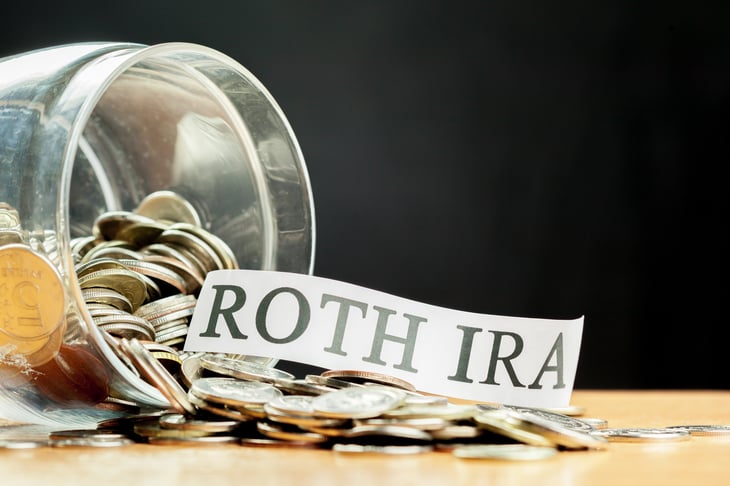
This story originally appeared on NewRetirement.
You’ve worked diligently and paid your taxes along the way. When retirement finally arrives, you deserve to collect at least some tax-free retirement income without Uncle Sam coming back for more.
With a bit of strategic planning, it’s possible to enjoy much or even most of your retirement income tax-free. The following sources are yours to take to the bank.
1. Roth IRA distributions

A Roth IRA isn’t entirely tax-free, but it’s tax-free when it matters most: during your retirement. You pay taxes on Roth IRA contributions for the tax year in which you earned the money, rather than the year in which you make the withdrawal.
The money that you invest in your Roth IRA grows tax-free until you’re ready to take a distribution. As long as you follow the IRS requirements for a “qualified distribution,” you won’t pay taxes or penalties on your Roth IRA income. The rules are:
- You opened your account at least five years ago.
- You are over the age of 59 ½.
Roth IRA accounts also offer tax-free income flexibility that other kinds of investment vehicles don’t. Namely, you can leave funds in your account as long as you live without having to take the required minimum distributions (RMD) associated with traditional IRAs.
Be sure to model a Roth conversion as part of your comprehensive retirement plan to really see the long-term benefits to your lifelong finances.
2. Health savings account (HSA) distributions

Your health savings account (HSA) is perhaps the most valuable retirement account you could have. Available only if you have a high-deductible health insurance plan, an HSA offers you a “triple tax benefit.”
As long as you follow the IRS rules (which can be a bit complicated), you’ll never pay federal taxes on the money in your HSA. Every contribution you make is tax-deductible, and the money grows tax-free. And as long as you use the money for medical expenses, the withdrawals are also tax-free.
Your HSA offers another major perk in retirement: no required minimum distribution (RMD). You can keep your HSA savings stashed away from year to year until you need to dip into your account to cover medical costs.
The IRS allows HSA payments for a wide range of procedures and treatments. So, whether you need drug prescriptions, dental care, insulin, physical therapy, surgery or about anything in between, your HSA savings can cover the cost, leaving your real income untouched.
3. Reverse mortgage payments

A reverse mortgage is a type of home loan that, in some situations, provides easy access to tax-free retirement income.
Homeowners 62 years of age and older are eligible to leverage the equity in their home for a reverse mortgage. A standard mortgage requires the homeowner to pay the bank. In a reverse mortgage, however, the bank pays the homeowner. Payments are available as a lump sum, monthly payments or line of credit.
The IRS clearly states that “reverse mortgage payments aren’t taxable.” Uncle Sam considers reverse mortgage payments to be loan proceeds, not income, so you can collect your lump sum or monthly payments without any tax burden. Additionally, since reverse mortgage payments aren’t viewed as income, they don’t negatively affect your Social Security or Medicare benefits.
Of course, reverse mortgages come with their own set of considerations and challenges, so they’re not the right answer for every retiree:
- You must continue to pay for repairs, property insurance and property taxes on the home after taking out a reverse mortgage.
- If you don’t repay the reverse mortgage before the end of your life, your estate must repay the loan, likely by selling the property.
- Reverse mortgages accrue interest and fees, just like other loans, so the amount you owe will be more than the amount you received.
A reverse mortgage shouldn’t be your only retirement income strategy, but it’s an important tool to consider if you have sufficient equity in your home and the benefits outweigh the drawbacks.
4. Profit for selling your home

As long as you have owned and used your home as your main residence for at least two of the past five years, you may qualify to exclude up to $250,000 of your home’s sale price from your income. The exclusion amount rises to $500,000 for couples filing a joint tax return.
Thanks to the capital gains tax exclusion implemented in the Taxpayer Relief Act of 1997, you can leverage up to $500,000 of tax-free income during your retirement. For example, if you and your spouse purchased your home for $200,000 but sold it for $800,000, then $500,000 of your $600,000 profit will remain untouched by federal taxes.
The IRS isn’t picky. Capital gains taxes apply to nearly every major purchase you’re likely to make, including investments, cars, boats and real estate. This is why it’s so important to use capital gains exclusions for every dollar that they’re worth.
5. Municipal bond interest

When you purchase a municipal bond, you provide a loan to your state or local government to fund public works projects like new hospitals, bridges and roads. The government doesn’t assess tax on the interest you make from such loans, which makes municipal bond interest a reliable form of tax-free income. This is exactly why financial advisers often encourage their clients to invest in municipal bonds as they approach retirement.
Your tax-free interest income can also be reinvested to achieve tax-free compound interest. On a standard taxable investment account, a tax rate of 30%-35% quickly shrinks a 10% rate of return down to a 6% rate of return. Municipal bonds legally circumvent such steep taxes so that you can leverage every penny of interest income.
6. Veterans benefits

If you receive benefits through the U.S. Department of Veterans Affairs (VA), you have access to retirement income that will never be taxed.
Although it’s true that military retirement pay is considered taxable income for federal income taxes, military disability retirement pay and a range of veterans’ disability benefits are partially or fully excluded from your total taxable income.
Military disability retirement pay may become a regular part of your tax-free retirement income as a pension or annuity if you:
- Were entitled to receive a disability payment before Sept. 25, 1975
- Receive disability payments for a combat-related injury
- Would be entitled to receive disability compensation from the Department of Veterans Affairs if you filed an application
Veterans benefits are also granted completely tax-free. Any payments granted to veterans and their families for the following purposes are not taxable:
- Disability compensation and payment
- Education and training
- Grants for vehicles for veterans who lose their limbs or vision
- Veterans insurance proceeds and dividends
- Interest on insurance dividends left on deposit with the VA
Overall, if you dedicated your life to protecting your country, retirement is the time for your country to show its thanks with the gift of tax-free income.
7. Social Security benefits

More than 64 million people receive Social Security benefits from the federal government each month. About 80% of these Social Security recipients are older Americans collecting the retirement income they earned during 40 or 50 years in the workplace.
It is possible, up to a point, to receive Social Security benefits without paying taxes on that money. If your combined income falls below a certain threshold, your Social Security retirement benefits remain 100% tax-free. While Social Security benefits are not always tax-free, if you calculate your tax strategy correctly by using the NewRetirement Planner, you can avoid paying taxes on much or possibly all of it.
The IRS calculates combined income as your adjusted gross income, plus nontaxable interest, plus half of your annual Social Security benefits. You can enjoy your benefits tax-free if your combined income falls below $25,000 as a single tax filer or below $34,000 as a couple filing taxes jointly.
The rules for how Social Security benefits are taxed can be a little overwhelming, but you can find a full explanation of how it works here.
Social Security benefits are also taxed by some states, so if you plan to relocate during retirement, it may also help to purchase your new home in one of the 37 states that don’t tax Social Security benefits.




Add a Comment
Our Policy: We welcome relevant and respectful comments in order to foster healthy and informative discussions. All other comments may be removed. Comments with links are automatically held for moderation.